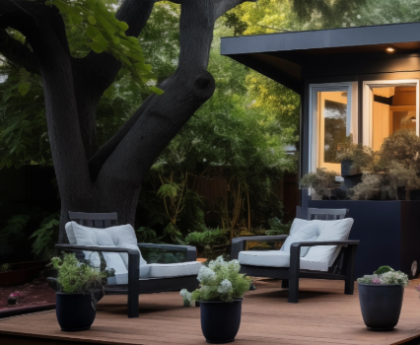LINCOLN, Neb. (Nebraska Examiner) – No one disagreed Tuesday with State Sen. John Lowe’s overarching premise: that Nebraska has a pressing need for more housing, particularly affordable.
But battle lines were drawn when it came to specifics of two Lowe proposals aimed at ramping up the number of “missing middle housing” duplexes and accessory dwelling units across the state.
Critics told the Legislature’s Urban Affairs Committee they had a problem with the proposals stripping certain zoning and regulation powers from local governments.
“This is a zoning matter best suited to be addressed at the local level,” said Eric Englund of the Omaha Planning Department, echoing the sentiments of other opponents who largely represented Nebraska municipalities.
‘Density is important’
Wrangling over Legislative Bills 1165 and 1166 went on for more than two hours at the legislative hearing.
Under Lowe’s duplex-focused LB 1165, cities of the metropolitan, primary and first class could not have zoning regulations on two-dwelling units that are more restrictive than those for single-family homes.
The other proposal, LB 1166, calls for municipalities to adopt zoning regulations that allow at least one accessory dwelling unit on a lot that contains a single-family dwelling. ADUs are second, smaller homes on the same property as a primary house. They’re sometimes called granny flats, in-law suites or garage conversions.
Lowe, of Kearney, said his proposals would eliminate the need for a related local public hearing, variance, conditional use permit or special exemption of zoning requirements beyond the determination that the land meets applicable zoning requirements.
The bills, he said, were based on concepts tried in Montana, a state he said faced similar housing challenges as Nebraska.
According to proponents, the increased housing density encouraged by the bills would lead to more affordable options at a time when high costs of home-building and rents have contributed to a housing crisis in Nebraska and elsewhere.
“Density is important — it’s how we get affordability,” said Ward F. Hoppe of Lincoln, a developer who said he also spoke on behalf of the Nebraska Realtors Association, Metro Omaha Builders Association and a few chambers of commerce.
‘Not in my back yard’
Nicole Fox of the freemarket think tank the Platte Institute, a supporter of Lowe’s proposals, said that while Nebraska needs more housing at affordable prices, few want such housing to be built near them.
That “Nimbyism” — not-in-my-backyard attitude — has led cities to enact local restrictions, she said. “The result is that too little housing gets built.”
Fox contends that the bills would “restore rights to local property owners by transferring control over what gets built.” She said the proposals would allow the housing market to better respond to demand for housing types.

Alex Johnson, a certified planner, said the legislation aligns with policy guidance of the American Planning Association.
He said resistance to missing middle housing, in the name of wanting to preserve a neighborhood, is often “racially coded language.”
Johnson said Nebraskans should look at the proposals as a “removal of barriers” rather than a blockage of local control.
Sticking out like sore thumb
Opponent Wayne Mortensen of NeighborWorks Lincoln, on the flip side, sees flaws. He said the accessory dwelling unit legislation, for example, would prohibit cities from regulating design of the housing, a power he said is necessary to avoid valuation decline and neighborhood concern.
“The quickest way to give ADUs a bad name is to have it stick out like a sore thumb in an existing neighborhood,” said another opponent, David Cary, director of the Lincoln and Lancaster County Planning Department.
Cary said Lincoln already allows accessory dwelling units to be built in the city’s lowest-density districts and is moving forward with ways to create more affordable housing.
Englund, Omaha’s assistant planning director, said Omaha also is in the process of implementing part of its housing affordability action plan — a guiding document required under a previous state law — to expand housing types throughout the city.
In February, he said, the Omaha City Council is to vote on zoning changes that would allow for more accessory housing to be built in areas outside of midtown.
But he said city planners still support certain controls that under the Lowe bills would be eliminated.
Mortensen suggested that the legislative committee focus instead on creating financial incentives or tools that would help homeowners build the accessory dwelling units, which he said can cost between $90,000 and $200,000.
ADU contest helps Omaha momentum
Todd Stubbendieck, state director of AARP Nebraska, supports both Lowe bills — and said his organization has been building momentum in particular for accessory dwelling units.
While ADUs alone won’t solve the state’s housing shortage, Stubbendieck said they provide a family-friendly housing option that can help. Among the benefits of ADUs, he said, is they allow older adults to age in place, by allowing a younger family member or caretaker to live nearby.
Under the legislation, the accessory dwelling unit may not be more than 75% of the gross floor area of the single-family dwelling or 1,000 square feet, whichever is less.
AARP recently partnered with the City of Omaha and other local agencies to raise awareness of accessory dwellings through a design contest. Three winners and an honorable mention emerged from about 20 professional competing designs.

Stubbendieck said the Omaha Planning Department agreed to create a “fast-track program” in which the winning designs can apply to be pre-approved by the city — thereby eliminating time in the building approval process.
Stubbendieck said he sees Omaha as becoming a success story for the accessory dwellings.
He said he is not blind to the concerns raised Tuesday about local control but said he believes that the proposed legislation would accelerate the use of the units.
“While I’m sensitive to these concerns, I’m concerned that a piecemeal approach to housing zoning reform specifically regarding ADUs will simply take too long and leave too many communities behind,” he said.
The Urban Affairs Committee did not take action Tuesday on whether to move the bills forward to full legislative debate.
Nebraska Examiner is part of States Newsroom, a network of news bureaus supported by grants and a coalition of donors as a 501c(3) public charity. Nebraska Examiner maintains editorial independence. Contact Editor Cate Folsom for questions: [email protected]. Follow Nebraska Examiner on Facebook and Twitter.
Copyright 2024 KOLN. All rights reserved.




